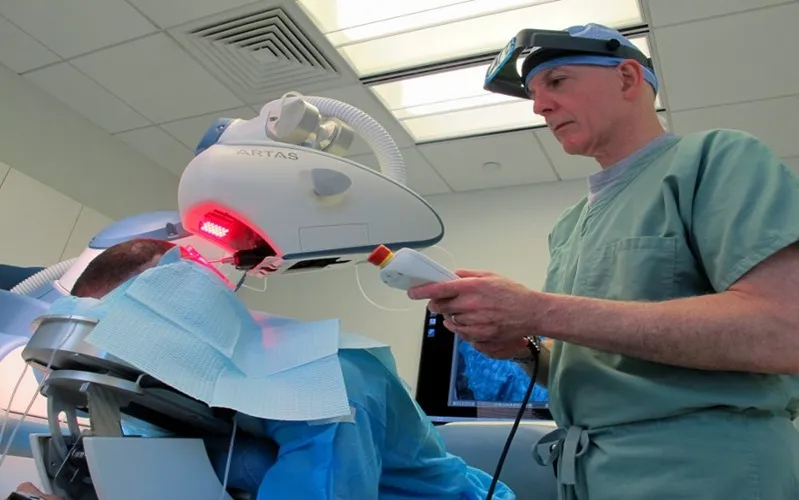Hair transplant technology has advanced significantly, with robotic hair transplants emerging as a highly effective solution for hair loss. This article will explore the benefits of robotic hair transplants, compare them to traditional methods, and help you determine if robotic hair transplant is the right choice for you.
Understanding Robotic Hair Transplant
Robotic hair transplant, particularly the ARTAS system, uses advanced robotics and artificial intelligence to perform hair follicle extraction and implantation. This technology aims to provide more precise and consistent results compared to traditional manual methods.
Key Features and Advantages
Advanced Imaging and Planning
Robotic hair transplant systems, such as the ARTAS iX, utilize high – resolution imaging technology. This allows the system to create a detailed 3D map of the scalp, accurately identifying individual hair follicles, their orientation, density, and quality. Using complex algorithms, the software can then select the most suitable follicles for extraction. The precision of follicle selection is far superior compared to manual methods. For example, the robotic system can precisely target follicles with optimal hair characteristics, ensuring a more natural – looking result.
Automated Extraction Process
The robotic arm in a robotic hair transplant system is programmed to extract follicles with a high degree of accuracy. The depth and angle of the extraction punch are precisely controlled, reducing the risk of damage to the follicles and surrounding tissues. This consistency in extraction leads to a higher survival rate of transplanted follicles. In traditional manual extraction, there is a greater chance of human error, such as inconsistent depth or angle of extraction, which can damage follicles and affect the overall success of the transplant.
Reduced Discomfort
The precision of robotic hair transplant systems reduces the trauma to the scalp during the extraction process. With less damage to the nerves and tissues, patients generally experience less pain during and after the procedure. The automated process also means that the surgery can be completed more quickly, minimizing the time patients spend in the operating room. Additionally, the shorter recovery time associated with robotic hair transplants allows patients to return to their normal activities sooner.
Enhanced Safety Features
Robotic hair transplant systems are equipped with multiple safety features. Sensors are used to detect any abnormal conditions, such as excessive force or movement. If any issues are detected, the system can automatically stop the extraction process, preventing potential harm to the patient.
Natural – Looking Appearance
The precision of follicle selection and implantation in robotic hair transplants results in a more natural – looking hairline and overall hair distribution. The robotic system can mimic the natural growth pattern of hair more accurately, creating a seamless blend between the transplanted hair and the existing hair.
Higher Success Rate
Due to the reduced damage to follicles during extraction and implantation, robotic hair transplants generally have a higher success rate. The transplanted follicles are more likely to survive and grow healthy hair, providing patients with long – term results.
Case Studies
Case 1: Tom’s Robotic Hair Transplant
Tom, a 40 – year – old man with male – pattern baldness, opted for a robotic hair transplant. The high – resolution imaging of the robotic system accurately mapped his scalp, and the automated extraction process was quick and precise. After the transplant, Tom experienced minimal discomfort during the recovery period. Within a few months, he noticed significant hair growth, and the hairline looked very natural. He was extremely satisfied with the results.
Case 2: Jane’s Traditional FUE Transplant
Jane, a 35 – year – old woman with thinning hair, chose a traditional FUE transplant. While the procedure improved her hair density to some extent, she was not entirely happy with the hairline. The incisions made during the implantation process did not perfectly match the natural hair growth pattern, resulting in a slightly artificial – looking hairline. She also experienced more discomfort during the recovery period compared to Tom.
Conclusion
In many aspects, robotic hair transplants offer significant advantages over traditional hair transplant methods. The precision, reduced patient discomfort, and more natural – looking long – term results make robotic hair transplants an attractive option for many. However, the higher cost is a factor that potential patients need to consider. Ultimately, the decision between robotic and traditional hair transplants depends on individual preferences, budget, and the extent of hair loss. It is crucial for patients to consult with a qualified hair transplant specialist who can assess their specific situation and recommend the most suitable approach.
Related topics:
- Cost of Robotic Hair Transplant: A Complete Guide
- Israel Introduces Robotic Hair Transplants for the First Time
- What is Robotic Hair Transplant: Things You Need To Know


